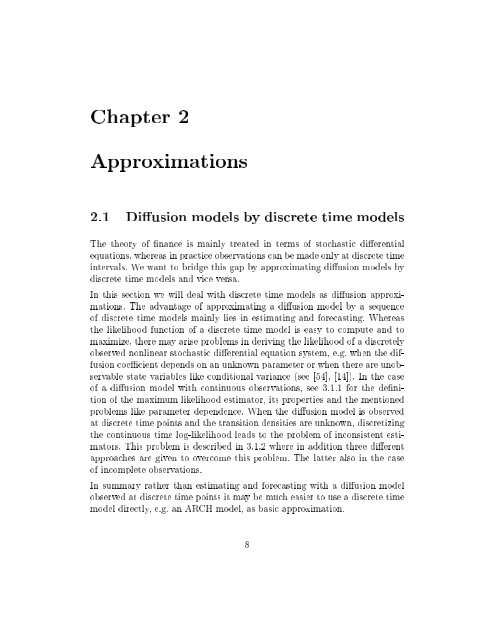Estimation in Financial Models - RiskLab
Estimation in Financial Models - RiskLab
Estimation in Financial Models - RiskLab
Create successful ePaper yourself
Turn your PDF publications into a flip-book with our unique Google optimized e-Paper software.
Chapter 2<br />
Approximations<br />
2.1 Diusion models by discrete time models<br />
The theory of nance is ma<strong>in</strong>ly treated <strong>in</strong> terms of stochastic dierential<br />
equations, whereas <strong>in</strong> practice observations can be made only at discrete time<br />
<strong>in</strong>tervals. We want to bridge this gap by approximat<strong>in</strong>g diusion models by<br />
discrete time models and vice versa.<br />
In this section we will deal with discrete time models as diusion approximations.<br />
The advantage of approximat<strong>in</strong>g a diusion model by a sequence<br />
of discrete time models ma<strong>in</strong>ly lies <strong>in</strong> estimat<strong>in</strong>g and forecast<strong>in</strong>g. Whereas<br />
the likelihood function of a discrete time model is easy to compute and to<br />
maximize, there may arise problems <strong>in</strong> deriv<strong>in</strong>g the likelihood of a discretely<br />
observed nonl<strong>in</strong>ear stochastic dierential equation system, e.g. when the diffusion<br />
coecient depends on an unknown parameter or when there are unobservable<br />
state variables like conditional variance (see [54], [14]). In the case<br />
of a diusion model with cont<strong>in</strong>uous observations, see 3.1.1 for the denition<br />
of the maximum likelihood estimator, its properties and the mentioned<br />
problems like parameter dependence. When the diusion model is observed<br />
at discrete time po<strong>in</strong>ts and the transition densities are unknown, discretiz<strong>in</strong>g<br />
the cont<strong>in</strong>uous time log-likelihood leads to the problem of <strong>in</strong>consistent estimators.<br />
This problem is described <strong>in</strong> 3.1.2 where <strong>in</strong> addition three dierent<br />
approaches are given to overcome this problem. The latter also <strong>in</strong> the case<br />
of <strong>in</strong>complete observations.<br />
In summary rather than estimat<strong>in</strong>g and forecast<strong>in</strong>g with a diusion model<br />
observed at discrete time po<strong>in</strong>ts it may bemuch easier to use a discrete time<br />
model directly, e.g. an ARCH model, as basic approximation.<br />
8
















